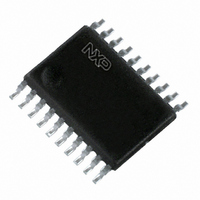P89LPC9241FDH,112 NXP Semiconductors, P89LPC9241FDH,112 Datasheet - Page 50

P89LPC9241FDH,112
Manufacturer Part Number
P89LPC9241FDH,112
Description
IC 80C51 MCU FLASH 4K 20-TSSOP
Manufacturer
NXP Semiconductors
Series
LPC900r
Datasheet
1.P89LPC9201FDH112.pdf
(75 pages)
Specifications of P89LPC9241FDH,112
Program Memory Type
FLASH
Program Memory Size
4KB (4K x 8)
Package / Case
20-TSSOP
Core Processor
8051
Core Size
8-Bit
Speed
18MHz
Connectivity
I²C, UART/USART
Peripherals
Brown-out Detect/Reset, POR, PWM, WDT
Number Of I /o
18
Ram Size
256 x 8
Voltage - Supply (vcc/vdd)
2.4 V ~ 3.6 V
Data Converters
A/D 4x8b; D/A 1x8b
Oscillator Type
Internal
Operating Temperature
-40°C ~ 85°C
Processor Series
P89LPC
Core
80C51
Data Bus Width
8 bit
Data Ram Size
256 B
Interface Type
I2C, SPI, UART
Maximum Clock Frequency
18 MHz
Number Of Programmable I/os
15
Number Of Timers
2
Operating Supply Voltage
2.4 V to 3.6 V
Maximum Operating Temperature
+ 85 C
Mounting Style
SMD/SMT
3rd Party Development Tools
PK51, CA51, A51, ULINK2
Minimum Operating Temperature
- 40 C
On-chip Adc
8 bit, 4 Channel
Lead Free Status / RoHS Status
Lead free / RoHS Compliant
Eeprom Size
-
Lead Free Status / Rohs Status
Lead free / RoHS Compliant
Other names
935288642112
NXP Semiconductors
P89LPC92X1
Product data sheet
8.10 Power-down and Idle mode
8.7 Boundary limits interrupt
8.8 DAC output to a port pin with high output impedance
8.9 Clock divider
Each of the A/D converters has both a high and low boundary limit register. The user may
select whether an interrupt is generated when the conversion result is within (or equal to)
the high and low boundary limits or when the conversion result is outside the boundary
limits. An interrupt will be generated, if enabled, if the result meets the selected interrupt
criteria. The boundary limit may be disabled by clearing the boundary limit interrupt
enable.
An early detection mechanism exists when the interrupt criteria has been selected to be
outside the boundary limits. In this case, after the four MSBs have been converted, these
four bits are compared with the four MSBs of the boundary high and low registers. If the
four MSBs of the conversion meet the interrupt criteria (i.e., outside the boundary limits)
an interrupt will be generated, if enabled. If the four MSBs do not meet the interrupt
criteria, the boundary limits will again be compared after all 8 bits have been converted.
The boundary status register (BNDSTA0) flags the channels which caused a boundary
interrupt.
The DAC block of ADC1 can be output to a port pin. In this mode, the AD1DAT3 register is
used to hold the value fed to the DAC. After a value has been written to the DAC (written
to AD1DAT3), the DAC output will appear on the channel 3 pin.
The ADC requires that its internal clock source be in the range of 320 kHz to 8 MHz to
maintain accuracy. A programmable clock divider that divides the clock from 1 to 8 is
provided for this purpose.
In Idle mode the ADC, if enabled, will continue to function and can cause the device to exit
Idle mode when the conversion is completed if the A/D interrupt is enabled. In
Power-down mode or Total Power-down mode, the A/D and temperature sensor do not
function. If temperature sensor or the A/D are enabled, they will consume power. Power
can be reduced by disabling temperature sensor and A/D.
All information provided in this document is subject to legal disclaimers.
Rev. 2 — 1 December 2010
P89LPC9201/9211/922A1/9241/
8-bit microcontroller with 8-bit ADC
© NXP B.V. 2010. All rights reserved.
50 of 75















